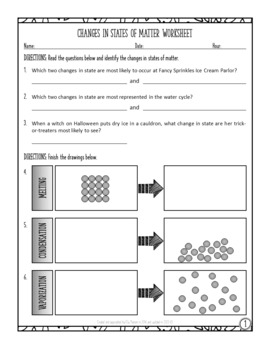

- #SIMPLE STATES OF MATTER INVESTIGATION 3RD GRADE ZIP#
- #SIMPLE STATES OF MATTER INVESTIGATION 3RD GRADE DOWNLOAD#

Head outside on a sunny day and place the bag of chocolate chips in the sun, laying it on pavement for the best exposure to heat. Instead, guide children to think of natural heat sources and it won’t be long before kids realize that the sun generates a lot of warmth! Using a stovetop would require the child to remove the chips from the bag, and if this is done in a classroom, a kitchen is most likely inaccessible. One popular solution is to pop that bag into the microwave, and while this can be done, it could easily make the chips burn. Explain that heat will make the chips melt into its liquid form, but a source of heat is needed to make this happen.
#SIMPLE STATES OF MATTER INVESTIGATION 3RD GRADE ZIP#
Be sure to zip the bag securely and ask your child to brainstorm of ways to make the chocolate melt. Help kids take the chocolate chips and add them to the bag. 1 quart-sized Ziploc bag per child or group of kids.This simple experiment is great for a hot sunny day and easily demonstrates how a solid can be converted to a liquid, and then back to a solid using a bit of energy. Regardless if you have a beginner or older child at home, the activities below won’t disappoint! Easily adaptable to the classroom, the following experiments are great for exploring the different states of matter and how they change for a summer filled with science fun! Chocolate Chip Experiment
#SIMPLE STATES OF MATTER INVESTIGATION 3RD GRADE DOWNLOAD#
Download today and try it free for 30 days!

Some concepts to explore with your older child include the following:Ī perfect complement to your student-centered classroom, the Talented and Gifted app reinforces projects and concepts as kids work at their own pace. It’s also simple enough to heat a pan of boiling water to see the steam rise from the pot, but older kids should know that matter can change under a variety of conditions depending on the substance involved. It’s easy to see ice cubes melt into water, but it takes much more patience to wait for it to evaporate to observe the change. Older children are better able to understand more about concepts that involve a change of state of matter. Stir up your child's interest in new learning routines with exciting science acitvities - interactive science worksheets, teacher-led videos and immersive games - available in Kids Academy Summer Camp! Subscribe today to secure a sizzling deal for a new school year. Likewise, if that ice cube is in a cup that stands on the counter for a number of days or weeks, your child will notice that the water evaporates because it turned into a gas that entered the air! For example, when ice cubes are frozen, they are solids, but can easily melt into liquids if left outside of the freezer. Help your child notice that some of substances on the list could change from one type of matter to another. Anything that emits a odor- and the smell itself!.It’s easy to review the three types of matter with young kids because there are so many examples that are easily accessible in your very own home! The following are household examples of matter to point out to your early learners: The first thing little learners should master is the three basic types: solids, liquids, and gasses. Chances are, if you have a child around ages 6-7, he or she has already learned about it, but might not have done much experimenting in school. Kids learn a variety of early physical science facts starting from preschool, but most kids start studying the states of matter by kindergarten or 1st grade.


 0 kommentar(er)
0 kommentar(er)
